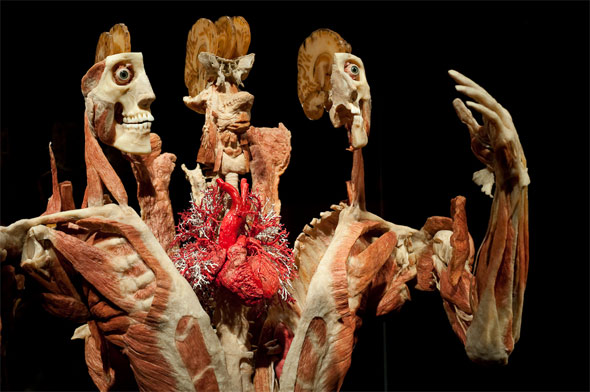Blog 4: MedTech + Art
When approaching the subject of medical technology in
conjunction to art, the concept of anatomy comes to mind, specifically that of
humans. For ages, scientists and artists have been fascinated by the ins and
outs of the human body, where one pursues to understand it and the other
aspires to be inspired by it. Through this week’s lecture by Dr. Vesna and the
readings, we have learned that modern medical technology development has
allowed scientists and artists alike to better comprehend the complexities of
the human anatomy, opening doors for novel development and new forms of
expression.
 |
| A display at Gunther von Hagens' Body Worlds exhibit |
Some artists have proposed that a better understanding of
our bodies can lead to better understanding of ourselves, not just as humans,
but as a society. When people can look past the clothes cladding our bodies,
the hair on our heads, and the color of our skins, we notice that all humans
are fundamentally the same underneath. From the number of bones and muscle
groups in our body, to the count of chromosomes that define our genetics, everyone
was defined to be essentially the same and is very difficult to distinguish
between individuals in this regards. Work such as Gunther von Hagens’ Body
Worlds achieves this through an exhibit of plastinated cadavers. His exhibit
dissociates the bodies from the individual and focuses more on the “raw”
expression of the subject, which viewers have often described to be somewhat
grotesque, but also beautiful and fascinating at the same time. Artists such as
Nick Veasey and Marilene Oliver have use this concept as well to create artwork
that addresses cultural disputes to spread tolerance and compassion. Their work
wouldn’t have been possible without medical developments such as X-Rays in the
19th century, along with MRI and CT Scan technology developed in the
20th century.
 |
| Artwork by Nick Veasey, capturing several subjects in a bus through X-ray imaging/ |
With our advance understanding in the human body, medical
technology is continuing to develop with prosthetic devices, where things have
evolved from a peg leg to fully functional mechanical hearts. For a long time,
writers and artists have fantasized the concept of a being that is part man and
part machine; a cyborg. Augment by machines and computers, a cyborg would be able
to transcend both the mental and physical capabilities of normal humans.
Although humanity is some distance away still from full-fledged cyborgs running
around, a lot of the art revolving it imposes a philosophical question of where
the threshold of being a man or a machine is drawn. With some sense of fear and
urgency, the viewers can’t help but be reminded of the Hippocratic Oath, and
whether this form of medical development will truly help all people, or lead to
our demise.
 |
| An animated franchise called "Ghost In The Shell", which focuses on dystopian future where the integration between man and machine has gone too far. |
References
Casini, Silvia. "Magnetic Resonance Imaging (MRI) as
Mirror and Portrait: MRI Configurations between Science and the Arts." Configurations (2011): 73-99. Web. 30
Apr. 2017.
Tyson, Peter. "The Hippocratic Oath Today." PBS.
Public Broadcasting Service, 27 Mar. 2001. Web. 30 Apr. 2017
"Ghost in the Shell Wiki." Ghost in the Shell
Wiki. Fandom, 20 Sept. 2011. Web. 30 Apr. 2017.
Bodyworlds. Institute for Plastination, 2006. Web. 30 Apr.
2017.
Sandler, Greg. "Unexpectedly Good Integrations In Life:
Artists Use Medical Technology For New Perspectives On Life." Unexpectedly Good Integrations in Life:
Artists Use Medical Technology For New Perspectives On Life. Adeptia, 14
Aug. 2015. Web. 30 Apr. 2017.

Comments
Post a Comment